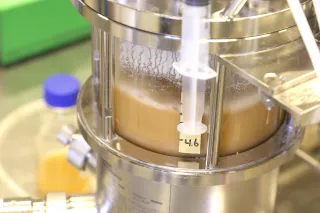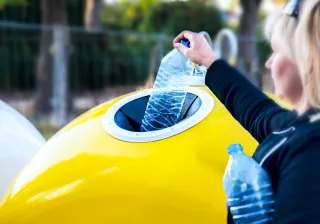Plastic waste ending up in oceans and nature is a major concern. The PlastBug project has looked into powerful microbes to break down plastics so that they can be turned into new raw materials. Kari Koivuranta and Jukka Niskanen share how the VTT iBEX innovation programme is developing the process of breaking down plastic waste with microbes. VTT’s expertise in biotechnology and chemistry has been a great asset in this research.
In recent years, researchers at VTT have identified microbes that break down different kinds of plastics and investigated which of their enzymes break down the plastics. As a result, there are already a few enzyme-related patents pending.
The production of plastics increases worldwide, and so does the amount of plastics waste. Plastic recycling is still inadequate, so a large part of plastic waste ends up being incinerated or in landfills.
Plastics contain a large amount of carbon that could be reused in new raw materials.
The PlastBug project has investigated how microbes with their enzymes can break down and digest different types of plastics and turn them into biodegradable materials such as fatty acids. Researchers are now developing chemical pre-treatment for plastics to make the break down process faster in the Degradable Polyolefins project. This way, the recycling of plastic waste becomes more effective, as the carbon contained in plastics becomes available for reuse.
“We mainly focus our research on polyethene and polypropene, which are the most common plastics in the world. These types of plastics are abundant in plastic waste, and they aren’t being fully reused. The biotechnological recycling of polyethene and polypropene hasn’t been researched widely, unlike PET plastics, for example”, explains VTT Principal Scientist Kari Koivuranta.
Pre-treatment makes plastics break down faster
VTT has already identified enzymes suitable for breaking down polyethene and polypropene.
“The downside of breaking down plastics this way is that it’s slow, which is due to the properties of the plastics. They are hard, durable and water-repellent, preventing the microbes and enzymes from getting into their surfaces”, says Koivuranta.
Additives used in plastics can also slow down the break down process: “Plastic isn’t synonymous with polymer: plastics consist of polymers and often contain additives. Additives improve the properties of plastics, but they may prevent microbial processing. Pre-treatment methods can help to decrease the amount of additives while the plastics are oxidised”, says VTT Senior Scientist Jukka Niskanen.
VTT is looking into how different pre-treatment methods affect the ability of enzymes to digest plastics. Oxidation is one way to improve the mixing of plastics in water and make the process faster. This research is facilitated by VTT’s expertise in plastics and polymer chemistry, while using industrially available methods.
Broken-down plastics turns into fatty acids
By breaking down plastics with microbes, enzymes and suitable pre-treatment, the carbon contained in plastics could be reused in the future. With the help of microbes, the materials created by breaking down plastics could be used to produce new biodegradable materials.
“Microbes can produce new materials from carbon sources, and this is already happening on an industrial scale. In the future, the carbon source could be plastic waste instead of sugars or wood, which we can use in other ways. Plastics also contain in general more carbon per gram compared to sugars, for example”, says Niskanen.
Carbon from plastic waste could be used to produce biodegradable material. Microbe strains can be adjusted to produce a certain product – such as biodegradable PHA (polyhydroxyalkanoate) plastic or fatty acids. One practical application of fatty acids is manufacturing raw materials for new plastics, and any excess material from the process would be used to grow new biomass.
Complementing current recycling methods
Recycling plastics is a challenge: even though plastics are being sorted, the majority of them end up being disposed of. Instead of competing with current recycling methods, the biotechnological recycling of plastics will be a complementary process. The aim is that the recyclable plastic could contain different types of plastics, and most of it could be reused.
The status of biotechnological plastic recycling is still unclear, and there are no existing ecosystems for utilising biodegradable materials produced from plastic waste. Likewise, there are no established terms or names for the products created by the process. VTT hopes to spark up conversation around this topic.
“So far, polyester has been used to biotechnologically produce comparable new polyesters, but there are no public examples of using plastic waste in general to produce biodegradable material. But this will be possible in the future: it may only be 5 to 10 years until we can use oil-based materials to make biodegradable and biocompatible materials”, Koivuranta says.






